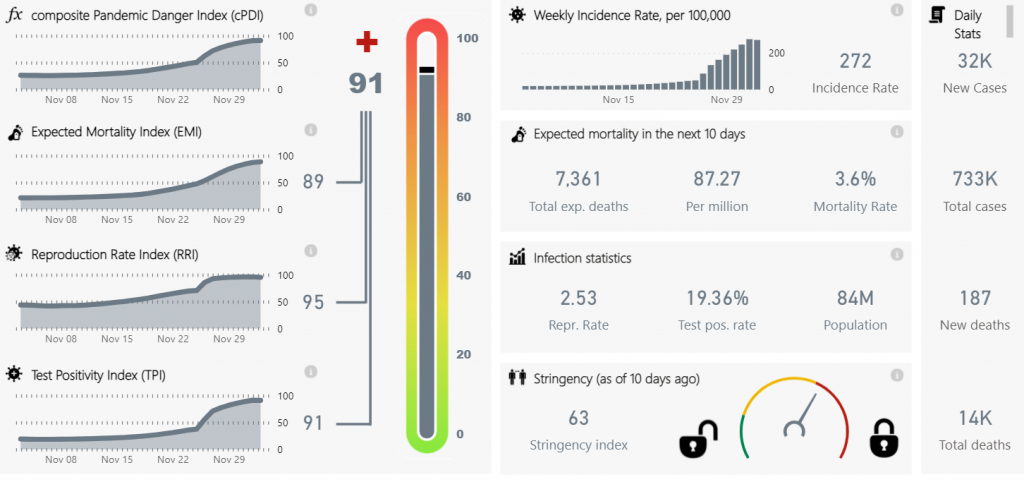For our first blog post, I’d like to address a curious situation that anyone following Pandemonitor might have noticed in the past few days – the astounding ascent of Turkey, from a cPDI of 50.4 (46th in the world) on Nov. 25th, to a score of 89 (and 1st place globally) on Dec. 1st, just six days later. To analyze what happened, I turned to Turkey’s page on the “single country” section of the dashboard, and realized immediately that the rise in cPDI is based on a sudden ‘jump’ in the incidence rate (weekly new cases per 100,000 people), which occurred on Nov 25th and caused the reproduction rate (R) to jump to levels that we haven’t seen since March (2.5 and up). Moreover, the test positivity rate jumped at the same point as well, hitting almost 20% by Dec. 3rd, and the mortality rate seemed off a well, reaching 3.6%.

The concurrent sudden change in all of these parameters led me to conclude that the sudden jump in Turkey’s status was not organic (i. e. reflecting a change in the development of the disease itself) but rather a result of data manipulation. I became even more convinced of this when I took a peek at the raw daily data, which showed a pronounced jump from Nov 24th to the Nov 25th – from about 6000 cases per day to around 28000. In addition, the data showed a pronounced rise in COVID-19 deaths starting in mid-November, 10 days before the current ‘jump’ (this rise is the reason for the rising mortality rate, as our model calculates it by dividing current deaths by the number of cases from 10 days ago). This rise in deaths means that a significant ‘second wave’ had been occurring in Turkey since early November, but was obscured by some kind of data manipulation until recently.
A little more digging found the source of this manipulation, in an AP article which reveals that “President Recep Tayyip Erdogan’s government this week resumed reporting all positive coronavirus tests — not just the number of patients being treated for symptoms”. What this means is that for a long time now, the Turkish government had been reporting only symptomatic cases, which seem to be (according to the new jump in the data) only about 20% of all verified, tested cases. This is a big deal, because it means that in the past months, the actual incidence rate in Turkey was about five times higher that reported, so that even in early Novemeber, when it was reported to be 19, it was actually around 100 – higher than the levels most countries use to define ‘green’ and ‘red’ destinations (this could have been a major problem, but most countries seem to be aware of the Turkish misreporting and defined Turkey as ‘red’ anyway).
For the purposes of our dashboard, this means that some of the results we’re seeing are not real, but rather an ‘effect’ of this sudden change in tabulation. The reproduction rate, for instance, isn’t actually 2.5 (calculating by the last 5 days rather than 10 gives a result of 1.66 – not good, but not as bad as 2.5) and the mortality rate should be about 5 times lower than it is (so around 0.75%), leading to a 10-day expected mortality figure of about 1500. When we put this all together, Turkey’s actual cPDI should be around 60 and rising – bad, but definitely not as bad as it seems. In the next 10 days, as the old (manipulated) data is gradually used less and less by our model, Turkey’s cPDI would slowly come down to its true level.
Interestingly, this episode serves to illustrate the power of our model: even with the manipulated data given by the Turkish government, it correctly concluded that things were getting worse, showing a rise of 23 points (27 to 50) from the 10th to the 25th of November. It did so by taking into account the rising reproduction rate (which was evident despite the government’s choice to report only symptomatic cases), as well as the rising mortality rates, which served as a warning sign that not all cases are being reported, This is why Turkey’ “corrected” cPDI today is actually not that far off from what the model calculated on the 25th of November.
